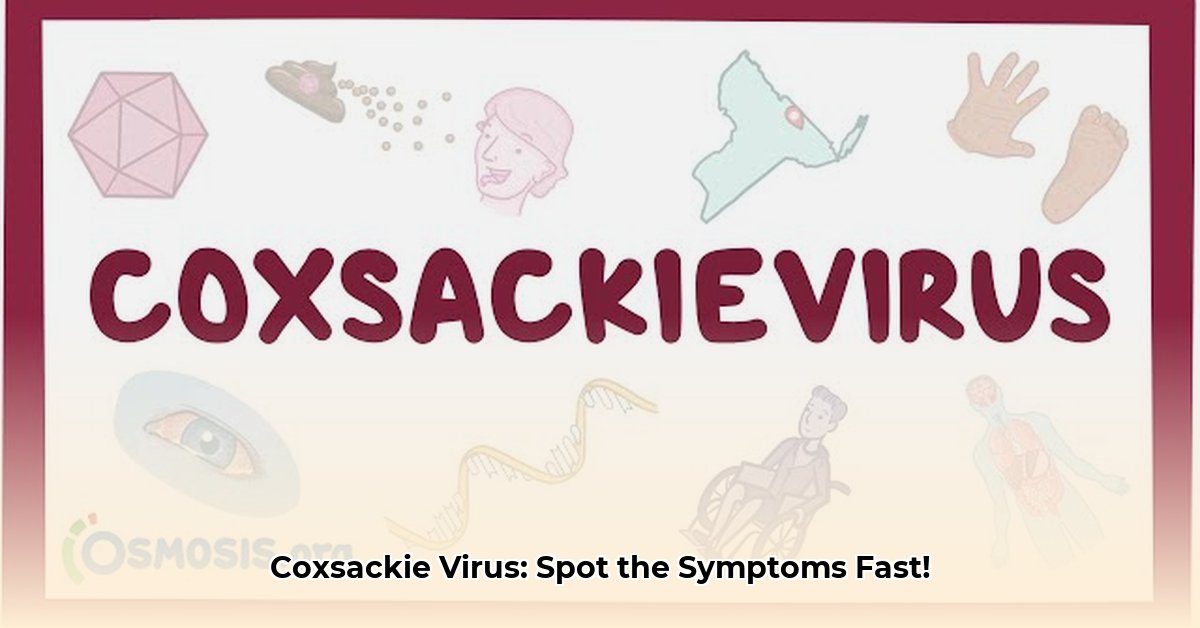
Coxsackie Virus Symptoms: Spotting the Signs Early
Is your little one feeling a bit off? A fever, a sore throat, or maybe a strange rash? Understanding the signs of Coxsackievirus is crucial for quick action. This guide helps you recognise common symptoms, prevent spread, and know when to seek medical help. Early detection makes a big difference in managing this common childhood illness.
Common Coxsackie Virus Symptoms in Kids (and Grown-Ups Too!)
Coxsackievirus often mimics a common cold or flu. While more prevalent in children, adults can also catch it.
- Fever: A high temperature (often a key indicator). Increased fussiness in young children is another sign.
- Sore throat: Often accompanied by painful blisters in the mouth, a strong sign of Coxsackievirus rather than a simple sore throat. Swallowing might be difficult and painful.
- Rash: Appearing as small blisters or red spots on the hands, feet, bottom, or face. It might be itchy or painful.
- Mouth sores: Tiny, painful blisters inside the mouth are a major indicator, commonly seen in hand, foot, and mouth disease (HFMD), a type of Coxsackievirus infection. This can make eating and drinking challenging.
These symptoms usually appear within three to six days of exposure. Most cases are mild and clear up within a week or two with rest and fluids.
"Most Coxsackievirus infections are mild and self-limiting," says Dr. Aisha Patel, Paediatrician at Chris Hani Baragwanath Hospital. "However, vigilance is key."
Did you know? Over 30 different Coxsackieviruses exist, causing a range of symptoms.
When Things Get a Little More Serious: Less Common, But Important Symptoms
Although most cases are mild, some Coxsackie infections can become more serious, particularly in babies, young children, and those with weakened immune systems. Watch out for:
- High and Persistent Fever: A fever that remains high despite treatment or is accompanied by other severe symptoms needs immediate medical attention.
- Trouble Breathing: Shortness of breath or difficulty breathing is a serious warning sign, suggesting the infection may have spread to the lungs. Seek immediate medical help.
- Extreme Fatigue (Lethargy): Unusual tiredness beyond typical cold or flu symptoms warrants immediate medical attention.
- Stiff Neck: Combined with fever, this could indicate meningitis, requiring urgent medical care.
- Dehydration: Vomiting and diarrhoea can lead to dehydration, especially in young children. Monitor fluid intake closely, and seek help if dehydration symptoms (dry mouth, dizziness, decreased urination) appear.
- Meningitis or Encephalitis: These rare but serious complications involve brain and spinal cord inflammation. Meningitis symptoms include severe headache, stiff neck, fever, and light sensitivity. Encephalitis can cause seizures and altered mental state. Immediate medical attention is crucial if you suspect either.
Remember, while these severe symptoms are less common, knowing them is vital. It's always best to err on the side of caution.
Fact: Early diagnosis and treatment are vital in preventing serious Coxsackievirus complications.
How to differentiate Coxsackievirus A and B infections in infants
Coxsackieviruses A and B cause varying illnesses in infants. Understanding the distinctions is crucial for appropriate care.
Understanding the Symptoms
While symptoms can overlap, some differences exist:
- Coxsackievirus A: Often causes hand, foot, and mouth disease (HFMD), with fever, sore throat, and a rash on the hands, feet, and in the mouth (tiny blisters). Herpangina (painful sores at the back of the throat) can also occur.
- Coxsackievirus B: Can cause more severe complications, though many infections remain mild. Symptoms include fever, irritability, and potentially meningitis or myocarditis (inflammation of the heart muscle), requiring immediate medical attention.
Differentiating between A and B solely on symptoms is difficult. A doctor needs to conduct tests for confirmation and severity assessment.
"Accurate diagnosis requires laboratory testing," explains Dr. Sipho Mthembu, Virologist at the National Institute for Communicable Diseases. "Clinical presentation alone isn't enough."
Key question: Has your infant exhibited any signs of unusual lethargy or respiratory distress alongside fever?
When to Worry: Recognizing Serious Signs
Seek immediate medical help for:
- High and persistent fever
- Lethargy (unusual sleepiness)
- Difficulty breathing
- Stiff neck
- Chest pain
- Dehydration
Supporting Your Infant's Recovery
Focus on supportive care once a Coxsackievirus infection is diagnosed:
- Plenty of fluids: Breast milk or formula are essential for hydration.
- Pain relief: Consult your doctor before using over-the-counter pain relievers.
- Rest: Adequate rest aids recovery.
- Hygiene: Maintain good hygiene to prevent spread.
Preventing the Spread: Hygiene is Key
Good hygiene is your best defence against Coxsackievirus:
- Frequent Handwashing: Wash hands thoroughly and often, especially after using the toilet, changing diapers, or before eating.
- Avoid Sharing: Don't share cups, utensils, towels, or personal items.
- Disinfect Surfaces: Clean and disinfect frequently touched surfaces if someone in your household is infected.
This information is for general knowledge only and should not replace professional medical advice. Always consult your doctor for diagnosis and treatment. Early detection leads to faster recovery.